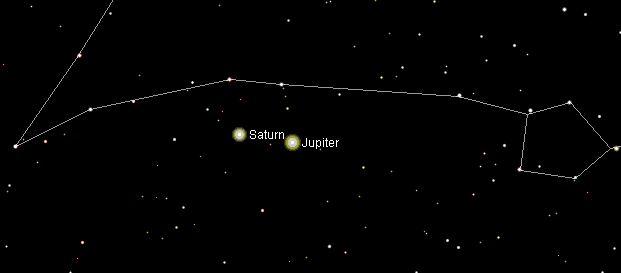|
The great conjunction of Jupiter and Saturn this year is rightly considered ‘the great one’. No encounter of any other visible planets has such a slow measured pace and dominates the night sky over a period of many years. It is the mightiest of all encounters in our solar system. Approximately every 19,86 years Jupiter and Saturn encounter each other, so that every ten years they stand together and then opposite each other—a ten-year pulse in our solar system. …This year Jupiter and Saturn meet in the space transitioning between Capricorn and Sagittarius. The last time they met in this area of the zodiac like this was in the year 1107. At Easter this year the three outer planets Mars, Jupiter and Saturn were within a span of only 8° from each other in the northern morning skies, with Jupiter and Saturn only 5° apart. Their close and impressive proximity to each other was a prelude for the conjunction of Jupiter and Saturn at Christmastide this year. As such, Easter and Christmas are bound together this year. Now in winter and into spring, like taking a last deep breath before the great meeting, is the loop movement of both planets. Jupiter releases itself out of the close proximity to Saturn a last time. It is interesting to observe now in the evening sky, if and how the new distance of 8° between the two, still seem as if they are a double star like in May when they were only 5° apart. Delightful, though, is that the gap between the two journeyers swings within the space between the two constellations of Sagittarius and Capricorn. It is like a planetary interval within the stellar interval: a gap within a gap which they create. This is the drama we can observe throughout the winter nights as they move from evening north-east to midnight in the north and morning north-west. Saturn ends its retrograde loop on Michaelmas day, 29th September, while Jupiter ends its loop on 13th September. It is like a pause before both planets begin their renewed movement towards each other first slowly, then ever more clearly noticeable: both heading towards the great conjunction. It is worthwhile looking up into the north eastern evening sky during the next three months and follow how these two giants on the periphery of our solar system ‘reach out’ towards each other. During this sojourn the constellation moves towards the north western horizon. The two flanking zodiac images of Sagittarius and Capricorn will pale, while only Jupiter and Saturn remain visible like a double star in the fading evening light. Thus the weeks of Advent take on a double meaning. It is not only about the arrival and birth of God, but also the conjunction of the two planets. They stand as two principles which can be ‘read’ clearly, because they are standing so close side by side. Jupiter’s light shines out brightly, extroverted, while Saturn’s light is drawn inward, introverted. Jupiter as the planet of order and power of thinking and Saturn as the planet of memory and maturing: two principles, which together epitomise what is Christian, are united in this conjunction. Just like Christ continuously refers back to the Old Testament and Jewish tradition while also separating himself from them as a new step (“Yet I say to you…”), so does Saturn represent history and Jupiter the present. The conjunction of Jupiter and Saturn has a Christian signature. In different ways, not least of all that Johannes Kepler understood the threefold conjunction of the two in the year 7 B.C. as the Star of the Wise Men. The great conjunction is not only an event of Jupiter and Saturn, but also of earth and sun and—with Pluto—the furthest periphery. It also orchestrates Mars and Venus. Mars is doing its loop in Pisces, the zodiac sign which like none other became a symbol of Christianity. The threefold conjunction of 7 B.C. occurred in this sign. Mars, the planet of energy and vigour, is active in this sign of carefully questioning and tentative feeling into…also this belongs to this year 2020. And finally Venus is also lined up: rushing forward this year in an impressive upward rising. While Jupiter and Saturn dominant the evening sky, Venus dominates the morning. High in the sky in the early spring mornings she moves from Cancer and its centre, ‘the crib’ (the open star cluster Presepe), to the ear of wheat in Virgo’s hand: a journey from birth to maturity. Invisible for the naked eye and only to be seen with a very strong telescope is the far-off small planet Pluto, situated within the span which Jupiter and Saturn create between themselves. Also at the great conjunction on 21st December Pluto will be there. Maybe this is an image indicating that this conjunction on the day of the summer solstice is not just an event of earth and sun, but also an event of the furthest radius of our circumference.
(Reference: Sternkalender 2020/2021, Verlag am Goetheanum, articles by Wolfgang Held, pgs.6/7, 122,124. Translated by R. Knausenberger)
0 Comments
|
Articles Archives
December 2020
2023 - January to December
2022 - January to December 2021 = January to December 2019 - January to December 2018 - January to December 2017 - January to December 2016 - January to December 2015 - January to December 2014 - November & December 2013 - July to December 2013 - January to June 2012 - April to December Send us your photos of community events.
Articles (prefaced by month number)
All
|




 RSS Feed
RSS Feed